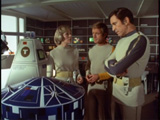
Episode Guide: Year One
Title: "The Last Sunset"
Within this page: Overview | Backplot | Plot Synopsis | Unanswered Questions | Analyses/Observations | Comments | Memorable Lines
Overview
Probes from the nearby world Ariel land on the lunar surface -- and create an Earth-like atmosphere on the Moon!
Production Number: 011 (Season One)
- filmed Tuesday, July 23 - Tuesday, August 6, 1974; Wednesday, August 21, 1974
Original U.K. airing week: 1 January 1976 (ATV Midlands)
Original U.S. airing week: 5 March 1976 (syndication)
Written by Christopher Penfold
Directed by Charles Crichton
Backplot
- In the year 1999, lunar nuclear waste storage dumps have exploded, due to magnetic radiation, sending Earth's moon into interstellar space. The inhabitants of Moonbase Alpha, unable to escape, are seeking a new home.
- The Alphans had previously dealt with the birth of Jackie Crawford (and subsequent alien possession of him and his mother, Cynthia Crawford) in the episode "Alpha Child."
- The Moon has been adrift in interstellar space before coming into orbit near Ariel.
Plot Synopsis
(From the original ITC Press Release.)
The prospect of a normal life dangles tantalizingly for the occupants of the runaway moon. Real air and sunshine. A new existence, similar to that on Earth. But there is drama behind the dream.
Since the day the Moon broke out of its orbit, life for the Moonbase Alpha personnel has been a strangely artificial existence, breathing made possible by the use of oxygen, life outside the base restricted to movements in pressurized spacesuits.
Now there is the prospect of normal life, with the warmth of a real sun, the invigoration of fresh air. They have found a new solar system with a planet Professor Bergman (BARRY MORSE) identifies as Ariel. Fears that an alien attache is being made prove to be groundless when a satellite-shaped object lands, pouring out a gas which creates fresh air. On the horizon, the long-forgotten sight of blue sky and a warm sun.
Gravity has returned. If the Moon can go into orbit, the gravity will be almost exactly equivalent to Earth's Dubious at first, Commander Koenig (MARTIN LANDAU) and Dr. Helena Russell (BARBARA BAIN) have to agree that the future is bright. The Moon could become a new Earth. They could settle and build outside the Alpha base, fertilise the lunar dust and raise crops, create rainfall with cloud-forming crystals.
Already, they can play games and sun-bathe in the open, and for Paul Morrow (PRENTIS HANCOCK) and Sandra Benes (ZIENIA MERTON) there is now hope of their loving blossoming into a normal Earth-like relationship, creating a future with a home of their own and children.
But a violent storm shakes the moon. Out on a recce (recon) in an Eagle, Helena, Paul and Sandra, piloted by Alan Carter (NICK TATE) are caught in the turbulence. The Eagle crashers and they are trapped. Sandra is injured and their water supply is contaminated. Paul, in search of water, finds a white substance, tastes it and finds that is slakes his thirst. They can survive. He carries Sandra to the hut he builds, declaiming exultantly that the future is theirs, but Helena and Alan realize that the situation is becoming even more desperate. Paul's mind has been affected by whatever it was that he tasted, and hopes of their being found by searchers from Moonbase Alpha are receding.
And from the planet Ariel there is at last verbal communication. The dream of the future is fading...
SCREENPLAY BY CHRISTOPHER PENFOLD
DIRECTED BY CHARLES CRICHTON
with
PRENTIS HANCOCK as PAUL MORROW
CLIFTON JONES as DAVID KANO
ZIENIA MERTON as SANDRA BENES
ANTON PHILLIPS as DR. MATHIAS
NICK TATE as ALAN CARTER
Unanswered Questions
- How were the probes from Ariel able to create atmosphere for the entire moon, given their size? Additionally, the Moon has a virtually non-existant magnetic field. How was the atmosphere held in check around the lunar body?
- Why did the beings of Ariel go to such extraordinary lengths to create -- then take away -- the Earth-like conditions?
- Why would Moonbase Alpha be equipped with sliding windows, such as Commander Koenig opened at Main Mission?
- Did the Mysterious Unknown Force (MUF) have any role within this episode?
Analyses/Observations
- "The Last Sunset" was one of the best Space: 1999 episodes for science "fiction" (due to the incredulous nature of the depicted events).
Comments
- How was it possible that the probes could quickly transform the Moon into an Earth-like environment. One theorizes that the probes may have been partially responsible for the Moon's Earth-like conditions, but that something on a grander scale was occuring without the Alphans' knowledge. Perhaps the probes were a physical manifestation to help the Alphans understand what was happening.
- If the probes were solely responsible for the transformation, one wonder how each probe could have carried the necessary materials/gasses to effectively create an Earth-like atmosphere.
Memorable Lines
Copyright 1999-2003 www.Space1999.org. All Rights Reserved. Legal
notice.
This work is licensed under a Creative
Commons License, in conjunction with our Open
Source Content Model. This site uses XHTML and CSS and looks best with
a standards compliant
browser.





